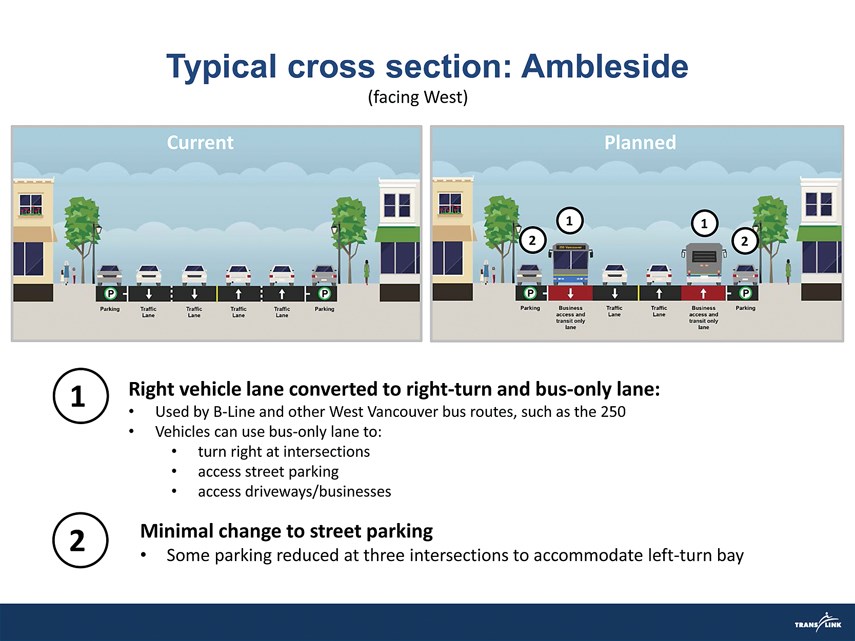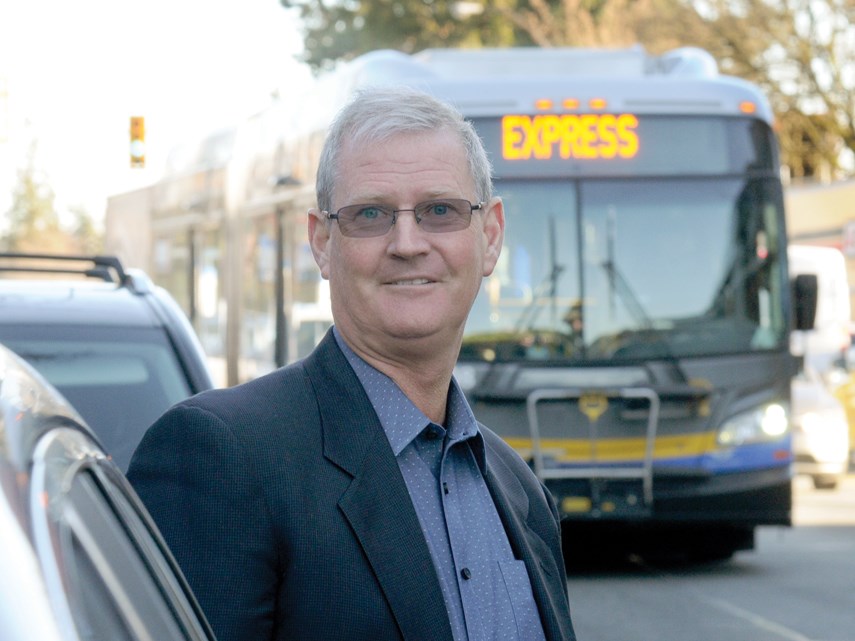When it comes to Ambleside, TransLink should stay in their lane and let drivers stay in theirs.
That’s the opinion of Nigel Malkin, an Ambleside merchant crusading against TransLink’s plan to give buses priority on Marine Drive beginning in the fall of 2019.
The Phibbs Exchange to Dundarave B-Line plan – which has yet to be approved by West Vancouver council – would allow drivers to use Marine Drive’s outside lanes to parallel park or turn right. The lanes would otherwise be reserved for buses. The project would also purge about 15 parking spots over a 20-block stretch to facilitate left-turn bays and bus stops.
That plan would devastate Ambleside businesses, according to Malkin.
“It’s going to destroy the community and it’s going to make it more difficult for West Vancouver residents to come to the Ambleside-Dundarave shopping area,” he said.
Malkin is spearheading a Saturday morning rally at 13th and Marine Drive in an attempt to force TransLink to take a detour.
“I’m going to go and cause complete and utter ruckus,” Malkin said. “I’m hoping we’ll have 500 or 1,000 people there and hopefully we shut down a lane of traffic because that’s what TransLink wants to do.”
There are misconceptions about the B-Line plan, according to TransLink media advisor Chris Bryan.
“There’s no lanes being closed,” he said, adding that Ambleside customers will continue to park along Marine Drive.
The plan should help assuage Marine Drive gridlock by separating left turners, right turners, and through traffic, resulting in a “net decrease to overall travel times,” Bryan said.
Bryan noted nearly half of West Vancouver’s municipal employees – including police officers, firefighters and librarians – commute from outside the district. He also noted about 40 per cent of North Shore employers are located within a brisk walk of the B-Line route.
With buses running every eight minutes during peak periods, the B-Line should relieve some of the area’s parking problems.
“Employees working in the Ambleside-Dundarave area will be more likely to leave their cars at home, freeing up parking and road space,” Bryan explained. “North Shore has not had an east-west option like this ever.”
But for the plan to work, the priority measures are essential, according to Bryan.
“To be blunt, B-Line success depends upon priority measures.”

The plan is a poor fit for a hamlet which includes residents with “among the highest incomes in Canada,” Malkin noted. “These residents rarely if ever use a bus and will never do so.”
The B-Line would be a boon to residents, responded Bryan. Dundarave denizens heading to Lions Gate Hospital and Ambleside residents bound for downtown Vancouver would see their travel times decrease by between five and eight minutes, Bryan said.
Malkin raised the concern that TransLink’s plan will send more drivers veering along side streets, making the area chaotic while offering little to the neighbourhood.
“Phibbs Exchange may as well be on the surface of the moon because there is nothing there,” he stated.
West Vancouver council has not made a final decision on the issue and is currently reviewing the plan, according to a statement from Mayor Mary-Ann Booth.
“We are listening to the community, studying the details and considering how to best meet the community’s needs,” she stated.
While he stopped short of endorsing the B-Line, Coun. Craig Cameron emphasized the need to adapt to changing conditions
The previous district council unanimously endorsed TransLink’s initial idea to bring the B-Line bus to Dundarave during a July meeting – albeit with a few caveats.
“To have any facsimile of road closure or takeover by TransLink is not in the cards,” Coun. Bill Soprovich said at the time.
Approximately 79 per cent of online respondents supported “street and traffic changes to make the B-Line faster,” according to a report from TransLink. However, that figure, like the rest of TransLink’s plan, requires closer examination, according to Ambleside-Dundarave Business Improvement Association executive director Stephanie Jones.
“A general survey saying, ‘Hey, we support the B-Line’ is not going to cut it,” she said. “Our residents need transit. Our customers need transit. Our employees need transit. And so saying ‘No’ to transit is not something in a survey environment you’re going to see people do.”
But the B-Line may be the wrong type of transit, according to Jones, who envisioned a “catastrophic” scenario in which Marine Drive becomes increasingly prone to gridlock, thus causing potential customers to avoid the area.
“We would like to see council and the mayor show some leadership and bring the community together,” she said.
Describing himself as “absolutely seething mad” at both the plan and the fact it was presented as a fait accompli, Malkin said he’s opted to endure the financial hardship of taking a week off work to fight the B-Line.
“I’m not against transit. I’m not even really against the B-Line,” he said. “The only issue that I have right now is the fact that they’re taking away two lanes from Ambleside.”
The proposal received a tepid response from the Ambleside and Dundarave Ratepayers’ Association. Despite “overwhelming support” for improved transit, some ADRA members are unconvinced of the merits of the B-Line plan with one member concerned the B-Line would bypass local businesses rather than serving them.
The B-Line plan is not scheduled to be on a council agenda in December.
The Marine Drive-Main Street route is “one of the slowest transit corridors on the North Shore,” according to a West Vancouver staff report.



